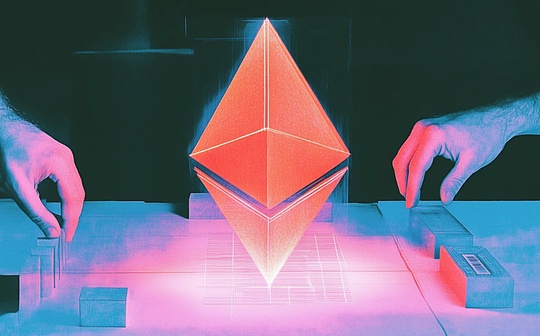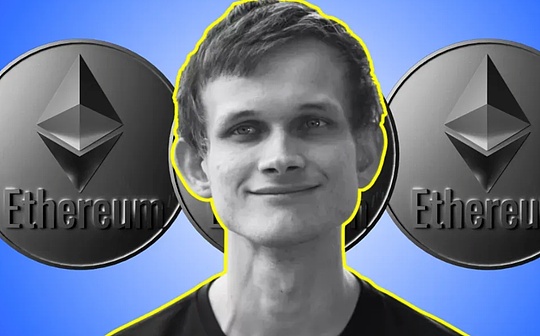
Author: Jack Inabinet, Bankless; Compilation: Baishui, Bitchain Vision
Ethereum’s spot ETFs may start trading at any time!
And one big question: How do we sell ETH to Wall Street?
This problem has plagued the industry many times.Although Bitcoin enthusiasts have always adhered to the easy-to-understand narrative of “digital gold”, it is often difficult for Ethereum fans to find a common, concise narrative to inspire outside interest in the ecosystem.
Today, each of the six major parts of this article summarizes the essence of Ethereum.We then explain why each narrative effectively attracts the next generation of investors to Ethereum and set a rating for each narrative based on how successful we think they are in attracting potential ETF buyers adoption.
“This is a tokenization platform”
Financial experts, including BlackRock CEO Larry Fink, have strongly praised tokenization, believing it represents a paradigm shift in the financial markets as it is expected to significantly reduce friction and costs.At the same time, it improves accessibility and liquidity.In addition, it is designed to achieve unprecedented transparency and composability!
Explaining the importance of Ethereum as the world’s leading tokenized asset platform in a way that TradFi participants can understand, sheds light on why the network is so important.
Although tokenization does not delve into the positive correlation between increasing on-chain activity and ETH price, it demonstrates the central role Ethereum can play in a modern financial system; achieving this alone will make ETH existingThe most valuable crypto assets.
This narrative captures the role of Ethereum as the global settlement layer of real-world assets, making it easier for TradFi to rationalize the role of Ethereum as the global settlement layer of the interconnected chain network and its pursuit of modular expansion.
Narrative Level: B
Although numerous financial institutions say they are excited about tokenization, this narrative is hampered by some regulatory uncertainty, luckily, investors’ excitement about tokenization may catalyze the necessary legislative action to provide the digitalRegulatory clarity of assets and their role in financial markets.
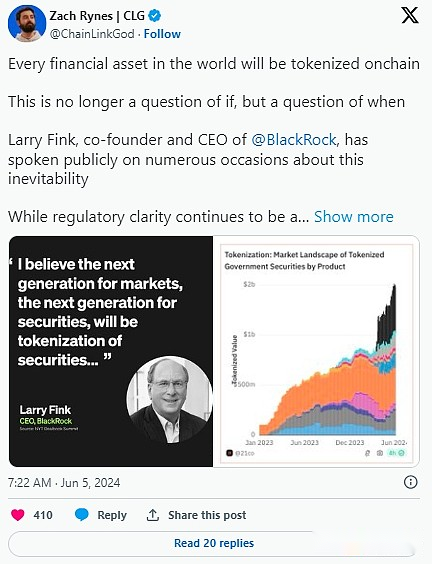
“Ethereum is an on-chain app store”
Unlike Bitcoin, Ethereum provides highly expressive smart contracts to unlock financial programmability for developers and make the network an on-chain version of Apple’s app store.
Those who download and fund Ethereum-compatible crypto wallets can have unrestricted access to a range of consumer applications that facilitate a variety of financial, gaming and cultural interactions.In this digital economy, ETH must be used to pay gas fees, which stimulates demand for ETH assets, and transaction fees payment becomes Ethereum’s revenue, which then flows to holders through Burn, a crypto-native version of stock buybacks!
Investing in ETH is similar to buying ownership of the app store directly,Many investors are willing to make this purchase because it has rich cash flow generation capabilities and strong network effects—both qualities are available to Ethereum.
Narrative Level: C
While this narrative has gained attention in recent weeks, becoming the best way to show ETH to TradFi and has similarities with familiar products, it is not clear whether external participants have a good understanding of how to perform on-chaintype of interaction, which may lead them to consider such activities of no value.
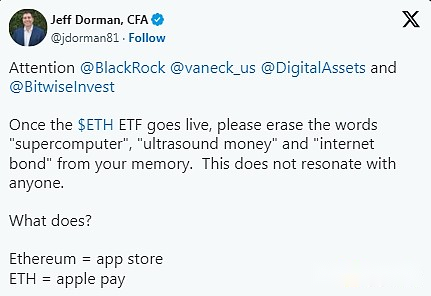
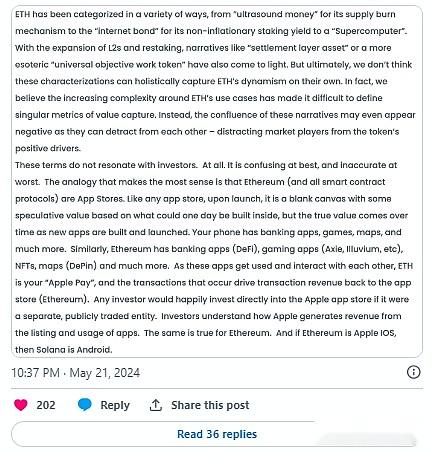
“This is an Internet bond”
In TradFi, it is easy to compare between cryptocurrency native staking plans and fixed income tools.
The pledger uses 32 ETH as the verifier collateral (principal) to receive a reward (interest).Unlike TradFi, this relationship does not depend on either party’s ability to repay loans, but is supported by immutable code and future economic activity of Ethereum – in the form of block fee income and inflation block rewards.
Investors of all kinds love to earn passive income from their assets, which leads many to think this is a perfect story for Ethereum, especially compared to the only alternative to TradFi transactions: non-productive BTC.
Narrative Level: C
Unfortunately, spot ETH ETFs will not be launched through pledges, and while cryptocurrency natives can continue to generate returns in this way, the narrative of “Internet Bonds” is unlikely to be attractive to investors who cannot use this feature., at least until the staking-enabled ETFs are launched.
“ETH is a super sound currency”
Bitcoin extremists have long believed in the “sound currency” principle of their chosen digital currency, emphasizing that the network’s programmatic block reward issuance program is depreciation-resistant, thus giving BTC a store of value status.
“Super Sound Currency” was created by the Ethereum ecosystem to make it a very different investment from Bitcoin and was first introduced in September 2020 by Ethereum Foundation Fellow Justin Drake before the last boomPromotion.
Although Ethereum currently has no guaranteed issuance plan, due to EIP-1559, the supply of ETH may turn into deflation as block demand increases, and the number of tokens in circulation will decrease over time, thusTheoretically, the tokens have excellent value storage quality, thus creating a “super sound currency”.
Narrative Level: D
The idea of deflationary tokens is attractive throughout 2021, but the narrative becomes less attractive as inflation drops sharply; if policymakers resort to depreciation to stimulate global economic downturns,Super-stable currencies may become the primary narrative.However, for Wall Street, this may be too depraved.
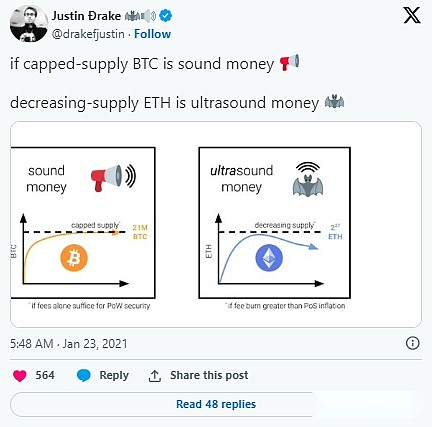
“This is digital oil”
Bitcoin may have earned the nickname “digital gold”, but who cares about a shining stone when you can have an alternative decentralized commodity that drives the global economy?
When trading on Ethereum L1 and many of its L2s, users must use Ether to pay the transaction fee to execute;Due to the widespread popularity of on-chain transactions in the Ethereum ecosystem, many people regard ETH as a digital derivative of oil.
Just like oil, it gains intrinsic value from its use as a key commodity, and Ether also benefits from the use of applications on Ethereum that require payment for gas to access.
Narrative Level: D
By showing the close link between activity and price, the increasing usage of Ethereum on-chain applications should have a positive impact on Ethereum, but this narrative seems difficult to convince traditional market participants as they are doing the on-chainShow resilience when interacting and do not fully understand what the on-chain economy is.
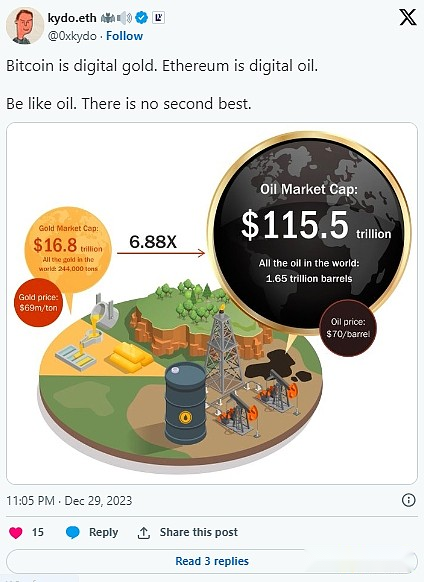
“This is Internet currency”
With Ethereum’s expressive smart contracts, developers can create applications on the blockchain, which, as mentioned above, represents TradFi as the next generation of app stores.
In this ecosystem, ETH is a native “Internet currency” as a medium for many to store their value and use it for payment.Furthermore, the existence of these smart contracts makes this currency programmable, allowing applications to use it automatically.
Among crypto users who were seeking asset utility, the ability to use Ether as a currency was an attractive use case that prompted many to adopt crypto, however, assuming that such statements could bring any excitement to the remaining TradFi adherents,Maybe a bit far-fetched.
Narrative Level: F
First, the concept of internet currency may not be taken seriously by mature/skilled investors attracted to ETFs.Furthermore, people usually don’t invest in currencies because they have inherent inflationary properties and their purchasing power decreases over time, a correlation that may make it difficult for investors to see the value of such assets.
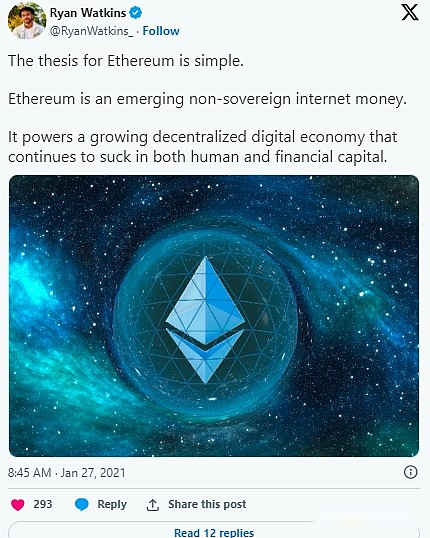
Why is there no “A” level?
The sharp-eyed readers may have noticed that none of the above narratives have achieved “A” level!
While each narrative has its appealing features, none is a magic bullet that can attract the next generation of investors to join Ethereum alone.
All of this is old or unproven, and while narratives can help investors understand all aspects of Ethereum, a comprehensive understanding of the network is necessary to fully grasp the revolutionary impact this technology may have…
For non-cryptocurrency locals designed to attract, the concept of tokenization is likely to allow them to recognize the importance of block space, acknowledging this is a prerequisite for mastering the concept of Ethereum, which is on-chainApp Store equivalent and unleash their ability to see Ethereum as digital oil and new form of currency!
Ethereum’s tokenization and internet bond narratives require clear regulation to truly gain attention, but at the same time, if policymakers resort to depreciation to launch a shaky global economy, the ecosystem can return to supersonic currencies at any time.
Ethereum may be too complex to boil down to a single narrative, but the effort to do so in presenting the ecosystem to outside investors in an approachable form may arouse their excitement and lead them to explore more deeply in the cryptocurrency’sRabbit Hole!

